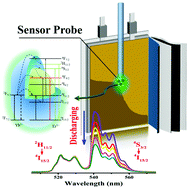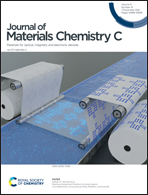Optical fiber sensor based on upconversion nanoparticles for internal temperature monitoring of Li-ion batteries†
Abstract
Temperature is a critical parameter for evaluating battery safety during the process of charging and discharging. However, it is a challenge to monitor it accurately because batteries are used in various compact environments such as energy stations. In this study, β-NaYF4:Er3+/Yb3+@NaYF4 nanoparticles were used to fabricate an optical fiber temperature sensor for battery temperature monitoring. The temperature sensing characteristics of the optical fiber sensor were explored in the range of 293–373 K using fluorescence intensity ratio (FIR) technology which can improve the temperature monitoring accuracy. The maximum relative sensitivity of the optical fiber sensor was 1.62% K−1 at 293 K and the temperature detection limit was within ±0.5 °C. By embedding the prepared sensor in a Li-ion battery, the proof of concept was obtained for monitoring the internal temperature of a battery with upconversion nanoparticles (UCNPs). A larger temperature variation was observed under a higher discharge rate. These results indicate that the prepared optical fiber sensor is an active tool for monitoring the thermal behavior and improving the safety of the battery.



 Please wait while we load your content...
Please wait while we load your content...